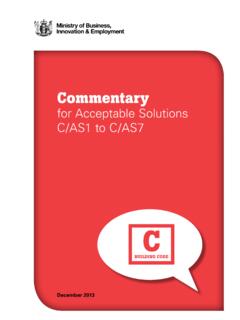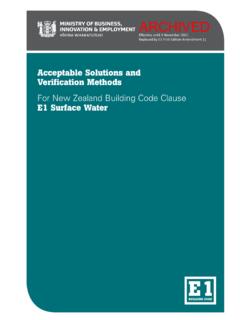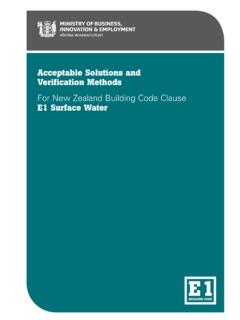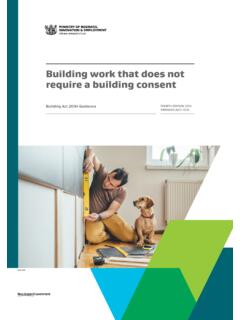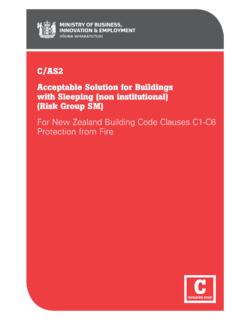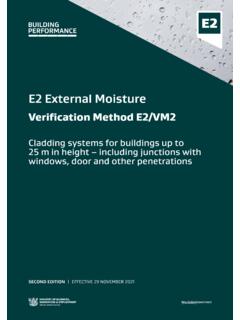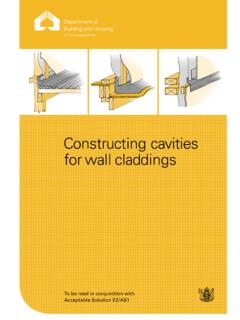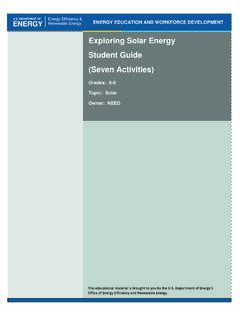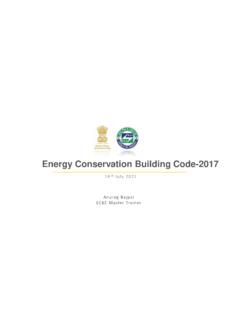Transcription of H1 Energy Efficiency
1 H1 Energy EfficiencyAcceptable Solution H1/AS2 Energy Efficiency for buildings greater than 300 m2 FIRST EDITION | EFFECTIVE 29 NOVEMBER 2021H1 Page 2H1 Energy Efficiency ACCEPTABLE SOLUTION H1/AS2 MINISTRY OF BUSINESS, INNOVATION AND EMPLOYMENT29 NOVEMBER 2021 PrefaceDocument statusThis document (H1/AS2) is an acceptable solution issued under section 22 (1) of the Building Act 2004 and is effective on 29 November 2021. It does not apply to building consent applications submitted before 29 November 2021. The previous Acceptable Solution H1/AS1 Fourth Edition Amendment 4, can be used to show compliance until 2 November 2022 and can be used for building consent applications submitted before 3 November Code regulatory systemEach acceptable solution outlines the provisions of the Building Code that it relates to. Complying with an acceptable solution or verification method is a way of complying with that part of the Building Code.
2 Other options for establishing compliance are listed in section 19 of the Building of the Building Code SystemBuildingActBuilding CodeObjectives, Functional requirements,Performance criteriaAlternative SolutionsMust demonstrate compliance with Performance criteriaGuidance issued under the Building ActInformationLegislation (mandatory)Compliance pathwaysDeemed to comply with Performance criteriaAcceptableSolutions** may include cited standards and informationVerification Methods*AcceptableSolutions*A building design must take into account all parts of the Building Code. The Building Code is located in Schedule 1 of the Building Regulations 1992 and available online at part of the Building Code that this acceptable solution relates to is clause H Energy Efficiency . Further information on the scope of this document is provided in the introduction on page information about the Building Code, the objectives, functional requirements and performance criteria provisions that it contains, and other acceptable solutions and verification methods are available at SITS HEREPage 3H1 Energy Efficiency ACCEPTABLE SOLUTION H1/AS2 MINISTRY OF BUSINESS, INNOVATION AND EMPLOYMENT29 NOVEMBER 2021 Main changes in this version and features of this documentMain changes in this versionThis is the first edition of H1/AS2.
3 However, prior to its release, similar requirements were previously found within H1/AS1. The main changes from H1/AS1 Fourth Edition Amendment 4 are: The scope of H1/AS1 has been reduced to cover only housing, and buildings other than housing less than 300 m . Requirements applicable to larger buildings have been combined into Acceptable Solution H1/AS2. To reflect the new scope of the documents and the new document layout, a new introduction and scope has been provided in part 1. General. Buildings with curtain walling have been excluded from the scope of H1/AS2. Citations of NZS 4218: 2009 thermal insulation Housing and small buildings and NZS : 2007 Energy Efficiency large buildings. Building thermal envelope have been removed from the document. The relevant content from these standards has been adopted into H1/AS1 and H1/AS2 with permission from Standards New Zealand. The minimum R-values previously found in NZS 4218 and NZS have been replaced with new values and new text in part 2.
4 Building thermal envelope. The requirements for determining the thermal resistance and construction R-value of building elements have been revised to better reflect the thermal performance of windows, doors, skylights and slab-on-ground floors. Portions of text have been re-written to enhance clarity in the document and provide consistent language with other acceptable solutions and verification methods. References have been revised to include only documents within the scope of H1/AS2 and have been amended to include the most recent version of AS/NZS in Appendix A. Additional references have been added to include BS EN 673, ISO 10077-1 and ISO 10077-2, ISO 13370, and ISO 13789 in Appendix A. The definitions page has been revised to include all defined terms used in this document in Appendix B. The three-zone climate zone map previously found in NZS 4218 and NZS has been updated with a six-zone climate zone map in Appendix C.
5 Requirements for establishing the orientation of a building have been added in Appendix D. A new procedure for calculating the construction R-value of windows, doors, and skylights has been added in Appendix E. Tables with construction R-values of selected slab-on-ground floor scenarios have been added to a new Appendix using this document should check for amendments on a regular basis. The Ministry of Business, Innovation and Employment may amend any part of any acceptable solution or verification method at any time. Up-to-date versions of acceptable solutions and verification methods are available from of this document For the purposes of Building Code compliance, the standards and documents referenced in this acceptable solution must be the editions, along with their specific amendments listed in Appendix A. Words in italic are defined at the end of this document in Appendix B. Hyperlinks are provided to cross-references within this document and to external websites and appear with a blue underline.
6 Classified uses for buildings, as described in clause A1 of the Building Code, are printed in bold in this document. These are denoted with classified use icons for:HHousingComCommercialOutOutbuildings CRCommunal residentialIndIndustrialAncAncillaryCNCo mmunal non-residential Appendices to this acceptable solution are part of, and have equal status to, the acceptable solution. Figures are informative only and the wording of the paragraphs takes precedence. Text boxes headed COMMENT occur throughout this document and are for guidance purposes 1. General ..5 Introduction .. 5 Using this acceptable solution.. 5 part 2. Building thermal envelope ..7 thermal resistance..7 Page 4H1 Energy Efficiency ACCEPTABLE SOLUTION H1/ASfiMINISTRY OF BUSINESS, INNOVATION AND EMPLOYMENT29 NOVEMBER thermal resistance .. Airflow .. Solar heat gains ..13 .. 11 . Solar heat gains.
7 11 part 3. Building services.. 12 Hot water systems..12 Artificial lighting..12 Appendix A. References .. 13 Appendix B. Definitions .. 15 Appendix C. New Zealand climate zones ..18 Climate zones ..18 Appendix D. Orientation.. 21 Orientation ..21 Appendix E. Windows, doors, and skylights..22 Vertical windows and doors .. 22 Skylights .. 23 Appendix F. thermal resistance of slab-on-ground floors ..24 Construction R-values.. 24 Page 5H1 Energy Efficiency ACCEPTABLE SOLUTION H1/AS2 MINISTRY OF BUSINESS, INNOVATION AND EMPLOYMENT29 NOVEMBER 2021 part 1. Scope of this This document can be used for buildings other than housing with an area of occupied space greater than 300 m . For all housing, and buildings other than housing with an occupied space less than 300 m , refer to the Acceptable Solution H1/AS1 or Verification Method H1/VM1 as a means to demonstrate compliance or use an alternative means to demonstrate Items outside the scope of this This acceptable solution does not include the use of foil This acceptable solution does not apply to buildings with curtain walling.
8 For these, use Verification Method H1/VM2 or use an alternative means to demonstrate For commercial buildings, this acceptable solution does not include requirements to comply with clause of the Building Code for the Energy Efficiency of HVAC systems. For this clause, use Verification Method H1/VM3 or use an alternative means to demonstrate Compliance This acceptable solution is one option that provides a means of establishing compliance with the performance criteria in Building Code clauses , , and Options for demonstrating compliance with H1 Energy Efficiency through the use of acceptable solutions and verification methods are summarised in Table Compliance may also be demonstrated using an alternative Using this acceptable Determining the classified Classified uses for buildings are described in clause A1 of the Building Code. Where a specific classified use is mentioned within a subheading and/or within the text of a paragraph, this requirement applies only to the specified classified use(s), and does not apply to other classified uses.
9 In buildings containing both industrial and other classified uses, the non-industrial portion shall be treated separately according to its classified use. For example, in a building containing both industrial and commercial classified uses, the commercial area shall meet the relevant Energy Efficiency requirements of the Building 6H1 Energy Efficiency ACCEPTABLE SOLUTION H1/AS2 MINISTRY OF BUSINESS, INNOVATION AND EMPLOYMENT29 NOVEMBER 2021 TABLE : Demonstrating compliance with H1 Energy Efficiency through acceptable solutions and verification methodsParagraph clauseApplies toRelevant acceptable solutions and verification methods (a) and (b) thermal EnvelopeH HousingCR Communal residentialCN Communal non-residential (assembly care only)Com CommercialFor housing, and buildings no greater than 300 m2: H1/AS1 or H1/VM1 For large buildings: H1/AS2 or H1 Building performance indexH HousingH1/AS1 or H1 (a) to (f) Physical conditionsAll buildingsFor housing, and buildings no greater than 300 m2: H1/AS1 or H1/VM1 For large buildings.
10 H1/AS2 or H1 (a) Heating of hot waterAll buildingsFor housing, and buildings no greater than 300 m2: H1/AS1 For large buildings: H1 (b) Storage vessels and distribution systemsIndividual storage vessels 700 L in capacity and distribution systemsFor housing, and buildings no greater than 300 m2: H1/AS1 For large buildings: H1 (c) Efficient use of hot waterH HousingH1 Artificial lightingLighting not provided solely to meet the requirements of Building Code clause F6 in:Com CN Commercial andCommunal non-residential having occupied space greater than 300 m2H1/AS2 HVAC systemsCom CommercialH1/VM3 GeneralPage 7H1 Energy Efficiency ACCEPTABLE SOLUTION H1/AS2 MINISTRY OF BUSINESS, INNOVATION AND EMPLOYMENT29 NOVEMBER 2021 part 2. Building thermal thermal Demonstrating For communal residential, communal non-residential assembly care, and commercial buildings, the building envelope shall be provided with construction that provides adequate thermal resistance.
